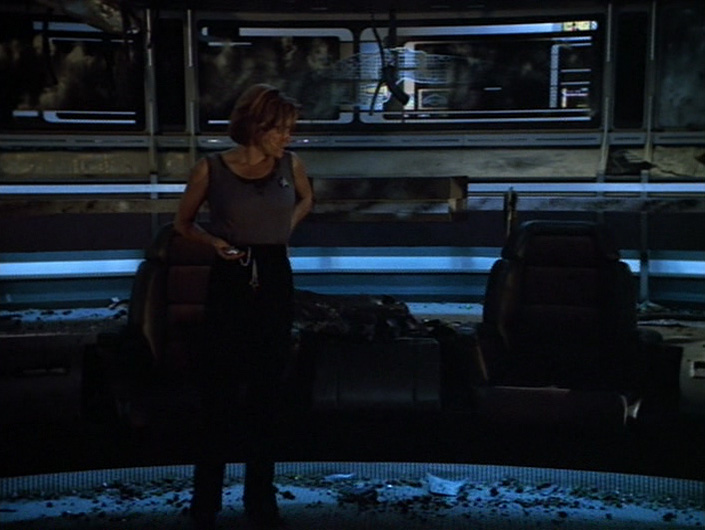 So far in 2020, the inhabitants of planet Earth have faced bushfires in Australia, a plague of locusts in East Africa, floods in Jakarta, multiple earthquakes in Puerto Rico, a murder hornet invasion, and the coronavirus pandemic that has brought modern society to a screeching halt. In Hong Kong, freedoms are being curtailed. In the U.S., the deplorable practices at border detention centers continue, police are murdering citizens and shooting paint at people on their porches, and in my home of mid-Michigan, a catastrophic dam failure exacerbated a flood, ripping out bridges and devastating the region.
So far in 2020, the inhabitants of planet Earth have faced bushfires in Australia, a plague of locusts in East Africa, floods in Jakarta, multiple earthquakes in Puerto Rico, a murder hornet invasion, and the coronavirus pandemic that has brought modern society to a screeching halt. In Hong Kong, freedoms are being curtailed. In the U.S., the deplorable practices at border detention centers continue, police are murdering citizens and shooting paint at people on their porches, and in my home of mid-Michigan, a catastrophic dam failure exacerbated a flood, ripping out bridges and devastating the region.
All this, riding on four years of federally sanctioned assaults on human rights, on environmental protections, and even on truth itself. Many of these problems have been brewing for decades or centuries, the festering consequences of unchecked capitalism, institutionalized racism, and human-caused climate change. While some of us cope by finding the dark humor in apocalypse bingo, at heart we are weary to say the least. Activism burnout is real and vicious, as is allostatic load in traumatic times.
And we’re only halfway through the year.
While Star Trek is often looked to as a source of hope and optimism, the franchise also depicts some compelling instances of resilience in the face of unspeakable suffering. Voyager’s two part “Year of Hell” episode in Season 4 puts the ship through the revolving hell of a fascist megalomaniac rewriting history, and I would argue the crew’s responses offer valuable insight for our own trek through troubled times.
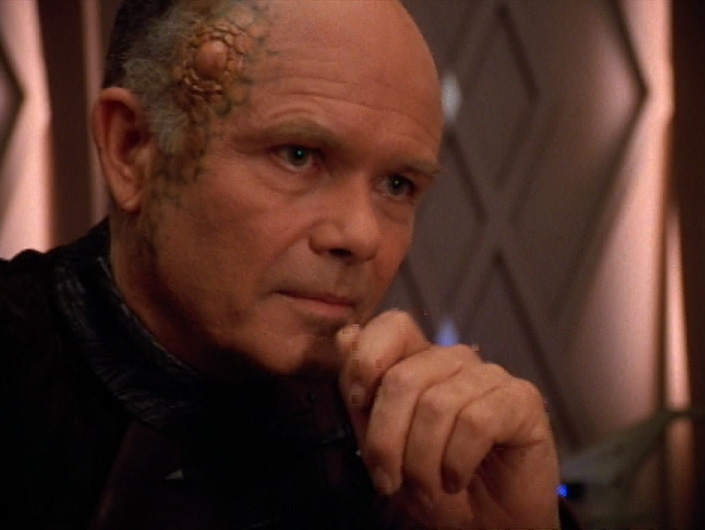
Annorax (Kurtwood Smith)
The central problem in the episode is caused by a man named Annorax, a Krenim officer bent on resurrecting the past to empower the Krenim empire while simultaneously bringing back his wife, a casualty to his own arrogant meddling. He is aiming for a “complete temporal restoration.” Make the Krenim Imperium Great Again, essentially. To do that, he uses a weapon ship which can alter reality using precisely-calculated temporal incursions, but it’s a bit like calculating orbit trajectories: screw up one variable and the outcome can be disastrous. Despite centuries of trying, he is never able to recover what he lost, and he destroys countless worlds in the process.
That is what makes Annorax such a pernicious villain–his willingness to “wipe out civilizations to help his own race,” as Tom Paris puts it. “We must erase the entire species from time,” Annorax says in the teaser. “Every lifeform, every molecule.” The episode does not explore the narratives of the billions of lives that are impacted by his genocide, but it is profoundly disturbing to think about that many voices being silenced.
Annorax’s authoritarian campaign has dire consequences for Voyager as well, which, when in the wrong place at the wrong time (pun intended), becomes the target of relentless Krenim attacks. So begins the crew’s year-long journey through privation, isolation, and loss. Early on, Deck 5 loses structural integrity, and the Doctor must leave people behind to die. The turbolifts are rendered inoperable. Tuvok is blinded by an explosion. By day 65, they’re on emergency rations. “I’m not sure what’s more difficult to maintain,” Captain Janeway says, “Voyager’s systems or the crew’s morale.” (I know the feeling–it is day 77 of quarantine for me as I write this, and I’m still trying to teach high school students). With half the ship destroyed and life support nearly gone, Janeway breaks her oath of keeping the family together, sending most of the crew off in escape pods for a better chance at survival.
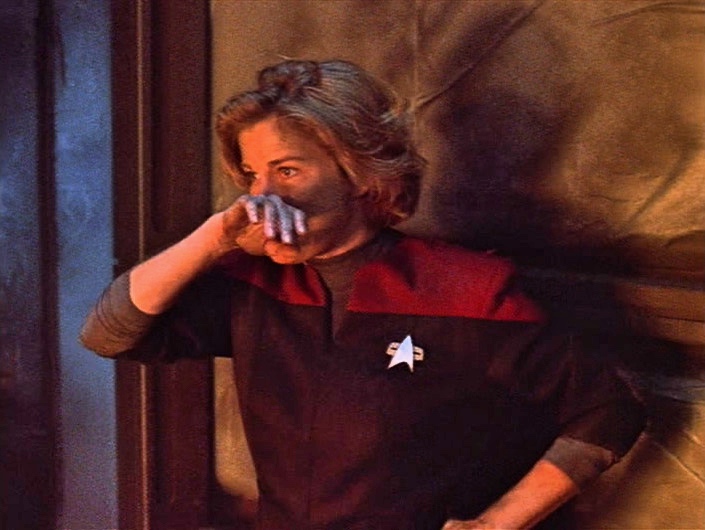
Through this harrowing trial, the Captain remains stalwart and resolute, charging boldly into everything from lung-searing gas to a fire in deflector control. Her dauntless grit is inspiring, but since she repeatedly refuses necessary medical treatment and rest, she is eventually diagnosed with Traumatic Stress Syndrome which affects her judgment. It’s a hard lesson for those who lead advocacy efforts in times of emergency–you can’t help the cause if you don’t keep yourself intact. Everyday Feminism has some solid suggestions of ways to prevent burnout, all of which are healthier than endless hyposprays of stimulants.
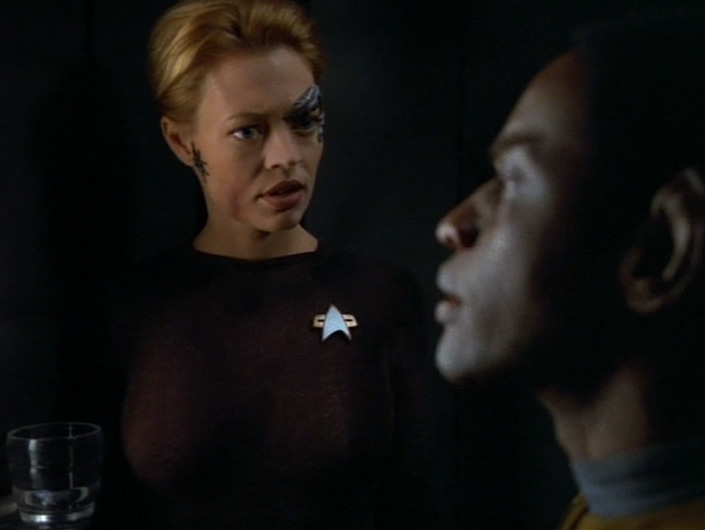
Seven and Tuvok
Despite the creeping despair, the crew manage to find strength in each other. Tuvok and Seven of Nine become close friends, a comradeship born of shared struggle and sacrifice, and their conversation inspires Seven to create temporal shielding that disrupts Annorax’s mission. Janeway’s sentimental objects become touchstones of human emotion in the midst of chaos–her teacup, a symbol of luck, doesn’t survive the fray, but the pocket watch from Chakotay, a symbol of hope, does. Tom and Chakotay, kept in solitary for months, must work together with Krenim officer Obrist to take the time ship’s temporal core offline. Voyager must ally with other ships to mount an offensive against Annorax.
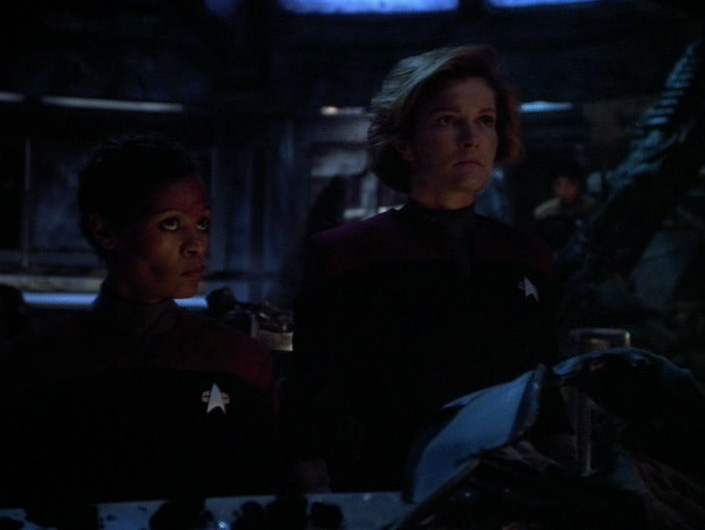
Janeway and an officer on the bridge during the Year of Hell
In all cases, it is collaborative effort that pulls them through. Social support, even from a safe distance, is essential to human well-being. As reported in a March 2020 Science Magazine article, studies have shown “a correlation between perceived social connectedness and stress responses.” Knowing we have friends we can count on lowers the overall stress load in the bodies.
The saga of stress in the episode ends when Janeway growls an iconic “Time’s up!” and crashes the remains of Voyager into the weapon ship, instantly restoring all of history to the pre-hell timeline. It’s as if their protracted fight for survival never happened, and the crewmembers recall none of it, continuing on their voyage in blissful ignorance.
For us, there is no reset button. There is no forgetting this year, nor should there be. The 100,000+ deaths from COVID-19 can never be undone. George Floyd and the long list of victims of police brutality cannot be brought back. We have no choice but to forge our own way out of these hells.
Activist Rebecca Solnit points out, “Many of these things — financial desperation and inequality and, you know, callous and selfish government — were already with us. And now we’re looking at them in a kind of stark new light…Disasters shake things loose. And the things that we regarded as fixed and unchangeable can suddenly be changed.” Just as Voyager was dragged out of its timeline, the events of 2020 have knocked the engines of our civilization out of the status quo, offering a rare chance to remake society, not in the selfish ethnocentric manner of Annorax, but as a people united by the democratic values of justice, equality, and the common good.
As Charles Marohn states in a March 16, 2020 article in Resilience, “Despite the scariness of the unknown, this is an opportunity to reshape the direction of our entire country. To make our systems more bottom-up and responsive. To make them more humane.” Time has long been up on this need.
As you weather the challenges you face in this historic moment, I hope you can pull some strength from Voyager. As Janeway says, “I say we make our stand together.” Practice self-care, stand in solidarity to protect others, and let’s build a future together that’s a little more Star Trek, and a little less 2020.
A brilliant two-parter of a brilliant series, with an equally brilliant article. Thank you; a very inspiring, wonderfully written and insightful piece.
I am no fan of Voyager. I remember very little of it but this two parter I enjoyed because there was a real sense of journey and movement within the framing device of being lost in the wrong quadrant. Inevitably the Pandemic brings into even sharper relief the nature of place. I spend half of my year in Indo China and New Zealand and half in the UK and Europe. To keep it simple the Virus looks and feels different in both but their are similarities 50% of the deaths in New Zealand are Elderly Dementia Patients and the UK 25% plus. The two parters core story is about the restoration of a Loved One. The behaviour of my two governments is to protect their health systems from being overwhelmed by the death of the elderly and generate huge debt for the next generation. The road to hell is paved with good intensions. I will not comment on the United States but here in New Zealand there is a real sense of community in amongst Paradise and Kiwi’s have in the main come together followed each level of lock down and are now ready to rebuild their shattered economy. Their are pockets of gang culture, a continuing entitlement narrative from the Maori (for which I have noticed an increasing resentment over the years not helped by their policy of reverse Ghettoisation), but what I hope they decide is to control inward tourism which brings little financial benefit and is disrupting the environment. People need to remember they can be happy and travel to the far reaches of their minds without moving.”As you walk and eat and travel, be where you are. Otherwise you will miss most of your life.” Buddha. Most tourists move their body and not their mind and are merely ticking boxes offered as a badge of success. The best journeying in Star Trek is within something Jim talks about in The Final Frontier.